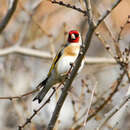Biology
provided by Arkive
Thanks to their long, pointed beaks, male goldfinches are the only birds that are able to extract seeds from teasel heads; they cling to the stem and tear into the seed head, accessing the seeds inside by probing with the bill (5). Females have shorter beaks and so they are unable to exploit teasel heads (5). In the autumn, when seed heads are common, goldfinches have a broad diet, feeding on groundsels, ragworts and dandelions as well as the favourite teasels and knapweeds (5). Outside of the breeding season, goldfinches roam in flocks in search of food during the day (2). At night they roost in evergreens or thick scrub. Flock size varies depending on the availability of food, but groups of 100 birds are quite common (5).
During spring goldfinches often display whilst sitting on branches, singing, drooping the wings and swaying from side to side (6). Between four and six eggs are produced and these take up to 14 days to incubate. The young goldfinches will have fledged after 13-18 days (3).
Conservation
provided by Arkive
Conservation action has not been targeted at this common species.
Description
provided by Arkive
The goldfinch is a strikingly beautiful bird, with a bright red face, black and white head and a deep golden yellow bar on the otherwise jet-black wings (2). Another notable feature is the long, pointed beak, which allows this species to extract seeds from teasels. Males and females are similar in appearance, although females have shorter beaks (5). Juveniles have greyish-brown streaked heads, lacking the red, white and black pattern of the adults (2). Flocks produce a delightful liquid twittering song and call (3).
Habitat
provided by Arkive
Breeds in mixed woodland, orchards, parks, commons, gardens and pine plantations (2) (3) where there are thistles and other plants that produce seeds (3).
Range
provided by Arkive
This finch is found throughout Britain, and is absent only in moorland and mountainous areas where their foodplants do not occur. They occur in the greatest numbers in the south. A large proportion of the goldfinch population migrates in September and October to spend the winter in mainland Europe (5). This species is found throughout much of western Eurasia (5).
Status
provided by Arkive
included in the Birds of Conservation Concern Amber List (medium conservation concern) (4).
Threats
provided by Arkive
This species is not threatened at the present time. The numbers of goldfinches in the UK dropped markedly between the 1970s and 1980s. This is thought to have been caused either by a decline in weed seeds as a result of agricultural intensification, or by increased hunting in the wintering range of the population (4). In the past this species was trapped and kept as a cage bird; in the mid-nineteenth century around 130,000 birds were trapped each year around Worthing, which is on a major migration route. One of the first tasks of the RSPB when it set up in 1904 was to protect this species. Trapping is now completely illegal (7).

